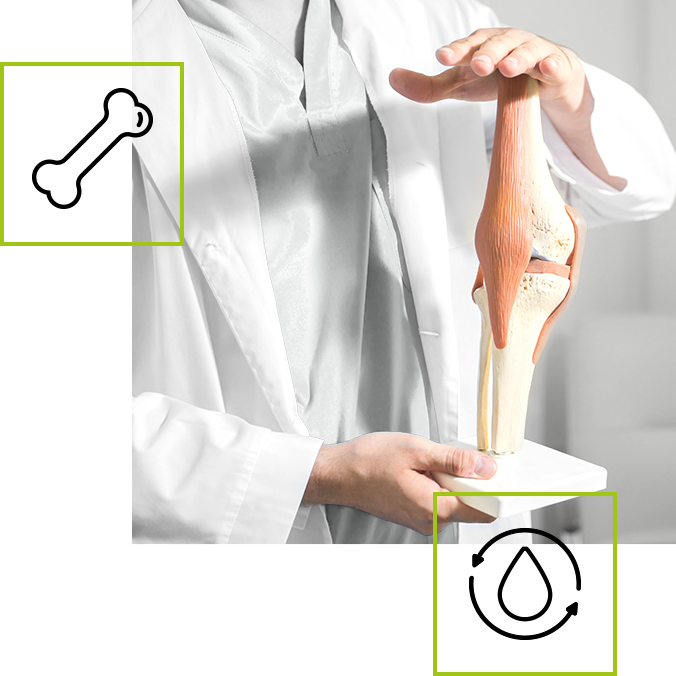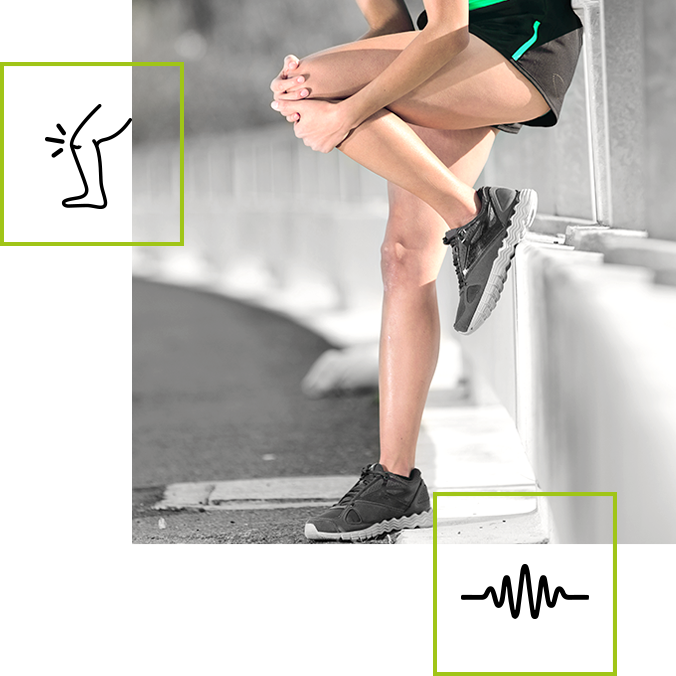Vibrotherapy – an effective method to combat knee pain
Vibrotherapy is an effective support in rehabilitation and recovery of knees for various types of injuries.
How does it work?
Vibrotherapy removes or relieves knee pain through several mechanisms: it stimulates both superficial and deeply localized pain receptors, raising the pain threshold over the long term, resulting in less pain; it improves blood circulation – it affects the dilation of blood vessels, regulating blood pressure; it improves lymphatic circulation; it promotes the relief of inflammation; it improves bone mineral density; it relaxes and strengthens muscles.


When and for whom?
Knee pain can have a variety of causes: rheumatic, degenerative, overload, neurological, and can also result from trauma. Vibrotherapy here can be a complementary or stand-alone therapy, depending on the cause of the pain, and is directed at people of all ages, both those with reduced physical activity and professional athletes.
Effectiveness
Just a single session of vibrotherapy conducted in people with knee osteoarthritis reduced the intensity of pain during step climbing by an average of 28%, the speed of step climbing by 11% and the speed of walking by 8%.

Park YG, Kwon BS, Park JW, Cha DY, Nam KY, Sim KB, Chang J, Lee HJ. Therapeutic effect of whole body vibration on chronic knee osteoarthritis. Ann Rehabil Med. 2013 Aug;37(4):505-15
Benefits of vibrotherapy

No side effects

Action confirmed by scientists and practitioners

Perceptible effects from 1 treatment

Long-lasting effects through systematic use
Choose the right product
We will help you select a set of modules that suits your conditions.
Degenerative knee pain
Osteoarthritis of the knee affects a large percentage of people over the age of 60. In Poland, no detailed studies have been conducted so far, but it is estimated that about 2 million people in our country suffer from osteoarthritis. All joints are affected, but it is the knee joints that are most often affected, followed by the hip and hand joints. Osteoarthritis of the knee is associated with degeneration and loss of articular cartilage. This degeneration includes softening, fibrosis and ulceration of the cartilage. Pathological changes are also noticeable in the subchondral bone tissue. The symptom of osteoarthritis is pain, increasing with movement and pressure, restriction of mobility in the joint, crackling, and sometimes swelling. A characteristic symptom is also the feeling of stiffness in the joint after sitting or standing for a long time or after waking up. Over time, there may also be problems with straightening the leg at the knee. Treatment includes a range of measures: from education, implementation of preventive management to inhibit/slow down degradation processes, through rehabilitation: physical treatments, kinesitherapy (physical exercises), massages, to drug treatment and surgery. Among physical treatments, the most commonly used for osteoarthritis of the knee are electro-, laser-, magnetotherapy, ultrasound, ion- and phonophoresis, cryotherapy and heat treatment. Vibrotherapy treatments can also be used at home.
Knee pain and rheumatic diseases
Another extremely annoying and difficult-to-treat cause of chronic, recurrent knee pain is rheumatic diseases: rheumatoid arthritis (RA) or ankylosing spondylitis (AS). Pain caused by rheumatic diseases is recurrent: it occurs during ordinary activity, one could say “without cause” (overloading, taking too long in one position, etc.). It is very often accompanied by swelling and redness of the knee, as well as a feeling of stiffness. Ankylosing spondylitis is a difficult disease to diagnose and occurs primarily in young people, while rheumatoid arthritis most often affects people between the ages of 30 and 50. Treatment of rheumatic diseases in Poland is mostly based on pharmacotherapy. Sufferers are less likely to turn to rehabilitation, which is a pity, as this can bring long-term improvement and does not generate side effects. A variety of physical treatments are available, including ultrasound, electrotherapy, cryotherapy, hydrotherapy, and magnetotherapy. Researchers here also observed the positive impact of vibrotherapy treatments: as many as 63% of those who underwent vibrotherapy sessions indicated an overall improvement in health and a reduction in overall fatigue.
Knee pain at night
The most misunderstood type of knee pain is the pain we experience at night. Why does the knee hurt when it is resting? The causes of knee pain at rest, such as at night while sleeping, can vary. The pains, which are described by patients as “sudden” and “excruciating”, may have a basis in the nervous system, such as compression of nerve roots extending from the spinal cord. On the other hand, pain of lesser severity, but more prolonged, may be related to inflammation within the knee joint. Night knee pain can also be exacerbated by rheumatic diseases. Then it is most often accompanied by morning joint stiffness.
Discomfort of living with knee osteoarthritis
Osteoarthritis is the most common joint dysfunction. It is caused by degeneration and loss of articular cartilage, which leads to joint dysfunction. Osteoarthritis of the knee is the most common cause of disability in the elderly, causing reduced muscle strength and impaired neuromuscular action. This has a negative impact on gait, including reduced speed, pace and stride length. People with knee osteoarthritis have difficulty performing daily activities such as getting up from a chair, climbing stairs, kneeling, standing and walking.
Better results of knee pain treatment with the inclusion of vibrotherapy
Standard treatment aims to alleviate symptoms through a variety of methods. In addition, physical treatments are used and physical activity is recommended, which can help increase muscle strength and improve balance. A growing body of scientific research suggests that vibration training has a positive effect on improving muscle strength, gait and balance. Such training may show advantages over traditional exercise programs because of the relatively mild impact and short duration of the training sessions. In addition, vibrotherapy can provide similar effects to weight training, but with less stress on the joints, and improve neuromuscular performance.
Knee pain resulting from overloading
Knee overload occurs as a result of intensive sports (this applies not only to professional athletes, but also to amateurs who suddenly begin to train intensively), hard physical work, and prolonged standing in one position (standing, kneeling, squatting). Strain pain also occurs more often in overweight people or in women with advanced pregnancy. The symptom of knee overload is inflammation, which causes pain that worsens when walking or bending the knee. Mobility is also limited and stiffness can be felt in the knee joint. Although it may seem that knee strain is not a very serious ailment, it should not be taken lightly. Indeed, the consequences of overloading can be damage to structures such as ligaments or joints, or bursitis of the knee. Treatment of overloaded knees is initially conservative – restriction of movement and overload, compresses, but once the inflammation has subsided, it is worthwhile to include physiotherapy and kinesitherapy (exercise). This will allow you to return to sports or recreational activities.
Knee pain - the most common cause
Knee pain due to injury. One of the most common injuries is a knee sprain. It can be associated with internal injuries in the knee – damage to the meniscus and cruciate ligaments or stretching of the attachments of the collateral ligaments. A knee sprain is almost always accompanied by swelling. The pain occurs primarily when walking and putting pressure on the affected structures. Treatment depends on the severity of the knee sprain: for grade I, it is enough just to limit recreational activity for a few weeks, while the most severe sprains may require surgical intervention.





